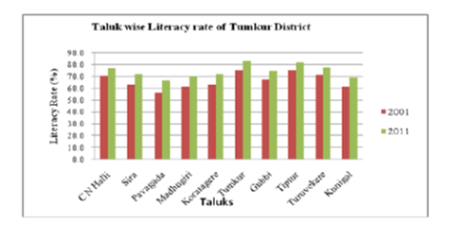
Geographical analysis
Department of Geography & GIS

Department of Geography & GIS

Geographical analysis
Year: 2018, Volume: 7, Issue: 1, Pages: 11-15
Original Article
M K Ningegowda1
1Assistant Prof of Geography, Pallagatti Adavappa First Grade College, Tiptur, Tumkur Dist
Received Date:04 January 2018, Accepted Date:23 May 2018
Literacy is considered as a fairly index of socio-Cultural and economic development of society / Population. Literacy is essential for eradicating poverty and mental isolation for cultivating peaceful and friendly relation at areas and area levels for permitting a free play of demographic process. Tumkur district is situated between 12°45’ and 14°20’ North latitudes and 76°20’ and 77°31’ East longitudes. The district has irregular shapes with peculiar features. The North Eastern part of the district is totally detached from the remaining part of the district. To know talukwise literacy in 2001 & 2011. To identify the change in literacy between 2001 & 2011. The methodology adopted to study the literacy characteristics of Tumkur districts with the help of secondary data collected from various departments of government. Simple statistical technology like diagrams, graphs and maps will be used to analyze the population aspects. However several maps will be prepared to show the location and physical aspects and various population characteristics of the study area with the help of GIS technology. Literacy of the district is characterised with sharp differences between the literacy rate of males & females and also rural & urban areas. Table represents the literacy level of population in India, Karnataka and Tumkur district according to 2001 and 2011 census. The total literacy level of India was 64.8% in 2001 and in 2011 it became 73.0% with the increase of 8.1%. Total male literacy was 75.3% in 2001 and 80.9% in 2011, which denotes a growth of 5.6%.
Keywords
Literacy, economic development, population
© 2018 Ningegowda. This is an open access article distributed under the terms of the Creative Commons Attribution License, which permits unrestricted use, distribution, and reproduction in any medium, provided the original author and source are credited.
Published By Bangalore University, Bengaluru, Karnataka
Subscribe now for latest articles and news.